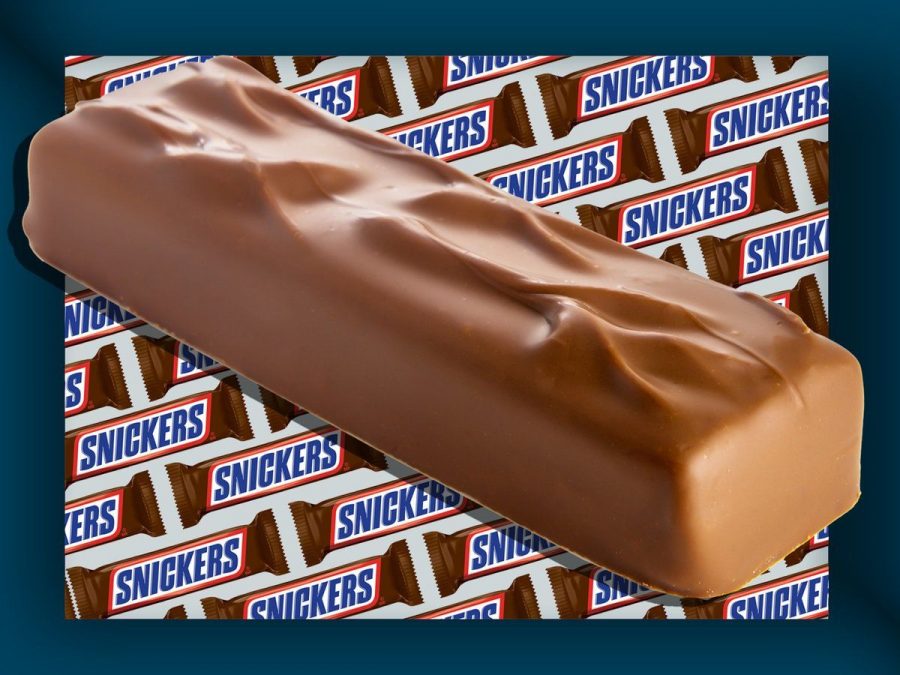Some Food For Thought Before I Eat a Snickers Bar
February 21, 2021
We’ve all been there. It’s 3pm after a boring school day. We’re feeling sluggish and wandering aimlessly around the house. We need an activity. Suddenly, on the kitchen counter a flash of brown catches our eye! “Yesss, a Snickers bar. Exactly what we need. A light snack to “get the pep back in our step and boost our mood. As Jake Paul would say, the ultimate “hype bite.” As described by Ardot, the snickers is the ideal satisfying snack! “Roasted peanut and caramel topped nougat enrobed in milk chocolate. A concept of simplicity, confectionary perfection, just pure chocolate, and peanuty genius.”
Instinctively, we tear in. After all, as they say, “you’re not you when you’re hungry!”
But wait, before you risk staining your new shirt with chocolate fingers, take a chill pill and freeze! Do you seriously need this? Snickers (also known as “cocoa loco”) do give us a quick energy boost and satisfy our taste buds, but, they are also called “a guilty pleasure” for a reason((;
Why do we feel we want/need a Snickers Bar?
First of all, the main reason is because we love the flavor. Simple and delicious, a Snickers bar is composed of chocolate, peanuts and caramel, or as Time Magazine says, pretty much the “the holy trinity of confection.” Naturally, we always want more of our favorite flavors. Career food scientists know this, and have used it to manipulate our brains. They promote Snickers as “satisfying” because they have designed them to tease our tongues. A single Snickers bar generally lasts only 1-3 bites. It has a lot of flavor in a short amount of time and our tongues can not process it in full. Automatically, we reach for another so that we can get a satisfactory experience.
Second, we can also have emotional attachments to the candy bar. It could be associated with childhood trick-or-treating or a special trip with grandpa to the ballpark. Either way, it provides us with a way to revisit those memories and are a form of comfort.
Lastly, in reference to nutrition doctor Dr. Eric Braveman, what makes us think we need/crave a Snickers is a dopamine deficiency. Dopamine is our brain’s natural power source which keeps us feeling happy and hyped all day. Without it, we feel sluggish. When our bodies are low on it, they encourage us to reach for sugar and simple carbs because they are the easiest to break down and therefore give us an instant energy boost.
Now, is it really worth it for only a few minutes of satisfaction?
In short, because of their non existent nutritional value, definitely not. Snickers bars are high in fat, salt, and sugar or, and as referred to by a Healthline study as “empty calories” [because they’re] “void of nutrients like vitamins, minerals, protein, fat, and fiber, which your body needs to function optimally.” Similarly, they are also the perfect recipe for body fat. According to Google Home, the Average American should consume no more than 30g of sugar and 60g of fat per day. Comparatively, a Snickers Bar weighs in at 27 grams of sugar and 15g of fat meaning that by eating it, as an average American, you will have fulfilled your daily sugar ration and ½ of your fat ration. (Remember, there is naturally a lot of sugar/fat in everything you eat for your normal daily meals such as butter, fruit etc… so when combined with the sugar in a Snickers, that is an overload.)
Now, according to a study on weight gain by Karan, in order to produce a pound of fat our body needs to store up 3,500 calories. Left over calories from past meals, and “empty calories” are automatically made into fat because our body cannot use them. Our body forms fat cells from excess calories just 4 hours after they are consumed. Thus, if you ate 500 calories of Snickers and did not burn them off within 4 hours, you would gain ⅕ of a pound of fat.
Along the same lines, if you are regulating your weight, a Snickers is not worth your time. A study by the Disabled World Health Food Education, concluded that in order to burn off 1 “fun sized” Snickers, we must undergo an intense 15 minute bike ride, or a 2.5 mile very brisk walk, or a 20 minute run, or 13 minutes of weight lifting, or a 10 minute swim. According to Baton Rouge Hospital Research Unit, it would take 17 minutes straight of burpees. Just thinking about that makes my legs and arms go numb.
Anyway, in summary, for two minutes of caramel goodness, you sacrifice an episode of your favorite show for torture time. Personally I love exercise, but I’d pass on the Snickers because Damon Salvatore (The Vampire Diaries) can’t wait.
Finally, it is natural to want to “treat” ourselves, but where should we draw the line?
Often, because we know the nutritional side effects, our justification for consumption is “its only one.” Theoretically this is true, however in reality, unless you’re a robot from Planet Fitness, it’s usually more and yep, that is actually perfectly fine. If you exercise before and eat a proper meal with plenty of lean proteins, nuts, whole grains, and dairy (all boost Dopamine production and reduce sugar craving and therefore consumption) a few once in a while won’t hurt you.
Problems occur when overconsumption compromises our health.
Often when you’re on a diet and seriously at your wits end, it’s normal to want a “cheat treat,” aka a Snickers. While as a level 10 gymnast with psychotic coaches, I totally feel where you’re coming from, “cheat treats” cross the line because they set a bad precedent. Though it appears small in the grand overview, ignoring your diet for One Snickers Bar gives you the idea that you do not have to fully commit to your goal for successful health and, trust me, it does make a big difference.
Finally, please don’t beat yourself up too hard. Having difficulty balancing them with a healthy lifestyle is not all your fault, and Campaign News US interviewed James Miller (global head of strategy at Mars Bars) to expose this. In order to boost sales, (Vice President of Mars Trade Development Department) Tim Quinn, has a few nasty tricks up his sleeve centered around manipulating our health concerns.
Recently, his main focus has been portion control because he says he “believes that there is ‘only an appropriate amount for one session.” He renamed the King-Sized candy bars 4-in-1’s (4 servings in one package; 1 for now, 3 for later) and “sharing size” bags are available pretty much everywhere. He wants you to believe that the company is taking care of you in the best way possible so that you can “snack without stress.” By doing so however, in a way he is also encouraging us to eat more Snickers because we stereotype smaller servings with a small impact. Similarly, when combined with their additively delicious flavor, our philosophy “just one more can’t hurt,” easily takes over our moderation and our diet.
Additionally, you’ve probably noticed that many of the Snickers Bars you buy have feelings such as “grouchy, loopy, snippy, or whiny” written on them instead of the usual logo. That is because the company is trying to have you associate eating Snickers Bars with relief and relaxation from stress. In other words, the company wants us to use food as emotional therapy. By the same token, a key trick lies in the word “snack.” The company wants us to incorporate their sugar products as a part of everyday life–something that we ingest regularly to keep ourselves happy. But sugar should be only a treat due to its non-existent nutritional benefits. Snickers should never be a substitute for an “after-school apple.”
No matter our mood, we must always eat to support our bodies. Before you ever bite into anything, you need to make sure you actually need it. Are you truly hungry, or just bored and food is a convenient source of fun? Are you actually feeling tired/sluggish, or is food a kind of mental therapy? Eating is only supposed to be a pleasant way of taking care of yourself, not a form of entertainment. If you feel hungry/are bored but know it’s not appropriate to eat, there are many great substitutes! If you need inspiration, here is a good link
https://www.healthline.com/nutrition/foods-that-fight-sugar-cravings
For further reference:
Ardot. “Why the Snickers Candy Bar Is the Best.” Delishably, A Maven Channel, 30 October 2011, https://delishably.com/desserts/Snickers-bars-are-the-best. Accessed 21 January.
Baton Rouge General. “How Many Crunches Does It Take To Burn Off That Fun-Sized Crunch Bar From Halloween.” Baton Rouge General, Baton Rouge Hospital, 21 October 2019, https://www.brgeneral.org/news-blog/2019/october/how-many-crunches-does-it-take-to-burn-off-that-/#:~:text=17%20minutes%20of%20burpees%20are,sized%20Snickers%20(160%20calories). Accessed 21 January 2021.
Braverman, Dr. Eric. “Why Snickers Really Satisfies.” Huff Post, Verizon Media, 11 July 2009, https://www.huffpost.com/entry/why-snickers-really-satis_b_213813. Accessed 21 January 2021.
Begley, Sarah. “The 13 Most Influential Candy Bars of All Time.” Time, Time Usa LLC, 17 February 2014, https://newsfeed.time.com/2014/02/18/13-most-influential-candy-bars-of-all-time/slide/snickers/. Accessed 21 January 2021.
Conick, Hal. “Mars Targets Healthier, On-the-Go CRowd With Snickers Crisper And Other C-Store Launches.” Confectionary News, William Reed Business Media, 14 October 2015, https://www.confectionerynews.com/Article/2015/10/15/Mars-targets-healthier-on-the-go-crowd-with-Snickers-Crsiper. Accessed 21 January 2021.
Karen. “How Long Does it Take To Gain Weight.” The Art of Doing Stuff, Karen Bertelsen, 12 June 2020, https://www.theartofdoingstuff.com/calorie-to-fat-timeline/. Accessed 21 January 2021.
Kubala, Jillian. “6 Ways Added Sugar Is Fattening.” Healthline, Red Ventures Company, 23 April 2019, https://www.healthline.com/nutrition/does-sugar-make-you-fat#TOC_TITLE_HDR_3. Accessed 21 January 2021.
Miller, James. “Case study: How fame made Snickers “you’re nt you when you’re hungry campaign a success.” US Campaign, Haymarket, 26 October 2016, https://www.campaignlive.com/article/case-study-fame-made-snickers-youre-not-when-youre-hungry-campaign-success/1413554. 21 January 2021.


